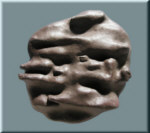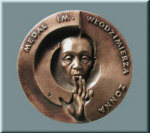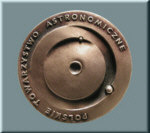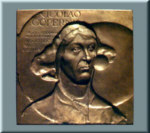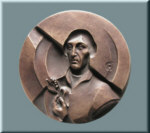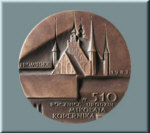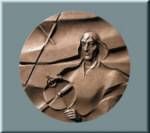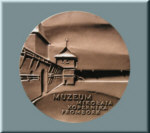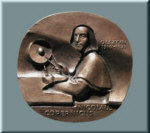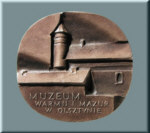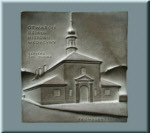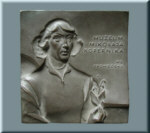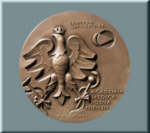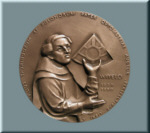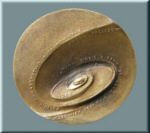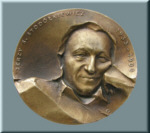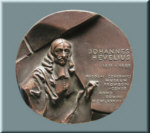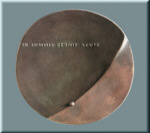( "Click" on the small pictures to see the large ones ).
Looking through Ewa Olszewska-Borys's medals, we can easily indicate a number of subjects dictated by, at the same time, the artist's predilections and the requirements of thecommission-giving bodies. This is true of her astronomical and Copernican medals, on the basis of which the most characteristic qualities of her work can be discussed thanks to the variety of the techniques used.
The development of artistic personalities is largely affected by the ideas inculcated in them by their professors, usually watching their first steps as artists. Ewa Olszewska-Borys was under the influence of the poetic quality of Professor Zofia Demkowska's medallic art (Academy of Fine Arts in Warsaw) and the precision of Professor Raymond Corbin's workmanship (Ecole des Beaux Arts in Paris). Significantly, in no other artistic discipline is the prompting of the commission-giving body or individual as audible as in medallic art.
The earliest and most original of Ewa Olszewska-Borys's pieces of the group under discussion are two ceramic medals which are at the same time excellent sculptured miniatures in the round, later cast in bronze. One features the mythological Icarus; the other, the Astronomer, is reminiscent in its lay-out of the dignified figures in mediaeval tympana. The shape of both allows us to classify them as works on the borderline of medal-making. Fine and powerful, they are freely modelled forms, apparently from the hand, and they are enriched with the additional value of colour. They also have a severe, primaeval kind of charm, and they tempt one to touch the concavities and examine the plasticity of the material. Largely enforced by the qualities of clay, the form does not interfere with the achievement of contradictory impressions of dynamism and stability.
The drama of the first man in space and the history of his flight to the Sun, generally known from mythology, indicates ancient art as the possible of source of inspiration because of the subject alone. The modelling of Icarus' body, and the setting of his head evidence the artist's knowledge of ancient Greek art combined with her own research (Ill. 1). There is a sense of peace in the composition of The Astronomer which may be inscribed in a rectangle triangle. The opening running diagonally through the sculpture does not upset the harmony; quite the contrary, it apparently cements two sides of the 'medal' together. Though ‘see-through’ sculptures were known as early as the beginning of the 20th century, this peculiar opening plays a different and in a sense innovative role.
Viewed as a whole, Ewa Olszewska-Borys's work reveals the main focus of her interest on portrait medals, struck and cast ones, commemorating personalities known from personal contacts and historic figures whose likeness has been popularized in prints and paintings. She deserves to be called the foremost Polish portraitist of the present, which is also evident in her medals on astronomical subjects. The likeness she renders using minimal artistic deformation owes its depth to the intimate trait in the treatment of the protagonists. The approach is the most distinct in the medal representing the outstanding Polish astronomer Wlodzimierz Zonn, an unconventional portrait catching the professor's characteristic gesture of the hand, all inscribed in cosmic spheres (Ill. 2, 2a). In this work, as in the representational portrait of Nicolaus Copernicus, the silhouette is visually connected with the background, usually a symbolic representation of outer space or the intimacy of a scholar's study.
Only the plaster model of the 20 zloty current Polish coin (issued in 1978) commemorating Miroslaw Hermaszewski's space travel stands out against the rest because of its flat background, as required by the Mint. An image of a helmeted head in a meniscus, it is reminiscent of a print at the expense of plastic qualities.
The largest set among the medals discussed are those celebrating Nicolaus Copernicus (b. Torun [German: Thorn], 1473; d. Frombork [German: Frauenburg], 1543). With the exception of his studies in Cracow and Italy, Copernicus spent almost all his life in the region of Warmia [German: Ermland]. Featuring the astronomer's likeness on the obverse, the medals have richly decorated reverses depicting the architectural highlights of the places of Copernicus' residence. A big one-sided plaquette cast in bronze is an exception. The work won the first prize in a 1973 sculptural competition. The artist relied on a portrait of Copernicus included in a 1645 print by Jeremias Falck of Gdansk [German: Danzig], also adopting the severe modelling of the prototype. The masterly incorporation of the head into the symbolic rendering of the heliocentric system comes as a result of the removal of parts of the background and the soft transitions between alternating convex and concave surfaces. Compared with the later portraits, this medallion is remarkable for the ceremonious quality of the monumentally treated head, and the perfectly harmonious composition (Ill. 3).
While working on her later Copernican portraits, the artist relied on equally popular iconographic evidence. The medals emerged in the following order:
Frombork 1983 w 510 rocznice urodzin Mikolaja Kopernika [Frombork 1983 on the 510th anniversary of Nicolaus Copernicus' birth], cast medal commissioned by the Councillors of the City of Frombork (Ill. 4, 4a). The bust of Copernicus with a lily of the valley in his hand is patterned on a 16th-century painting by Tobias Stimmer featuring on the astronomical clock of Strasbourg Cathedral.
Muzeum Mikolaja Kopernika Frombork 1986 [The Nicolaus Copernicus Museum Frombork 1986], struck medal (Ill. 5, 5a). The figure is not patterned directly on any popular image , but is a compilation of qualities of various portraits that are originally transposed, as a result of which we have a vigorous, dynamic silhouette with a subtly modelled head.
Muzeum Warmii i Mazur w Olsztynie [Museum of Warmia and Mazuria in Olsztyn], Nicolaus Copernicus Olsztyn 1516–1521, cast medal (Ill. 6, 6a). Copernicus is represented at a table with measuring instruments as in Marco Basaiti's 1512 painting from the collection of prince Andrzej Lubomirski in Lwow [now L'viv, Ukraine]. It may be a portrait of an Italian Renaissance scholar rather than Copernicus, but it has been fairly frequently reproduced as the famous astronomer's likeness. The artist has intuitively made it similar to Copernicus' familiar face: Muzeum Mikolaja Kopernika we Fromborku Otwarcie Dzialu Historii Medycyny Szpital Sw. Ducha [The Nicolaus Copernicus Museum in Frombork/ Opening of the Department of Medicine History/ The Holy Spirit Hospital] Frombork 1989, bi-sided plaquette, cast bronze (Ill. 7, 7a). The image of Copernicus is modelled on a 16th-century woodcut known as the ‘Reusner Portrait’. A physician as well as an astronomer, Copernicus is shown with several plants in his hand, among them a lily of the valley, his attribute in a number of pictures and sculptures.
Ewa Olszewska-Borys's medals featuring outstanding scholars also include one struck in commemoration of Vitelius [real name: Ciolek], Silesian philosopher, natural historianand mathematician, the author of Perspectiva also known as Optics (Ill. 8, 8a). Vitelius lived in 1225–1290. Ingenious composition directs the viewer's attention to the scientific instruments rather than the face of the scholar of a long gone epoch.
The medal featuring the contemporary Polish astronomer Jerzy Stodolkiewicz (l933–1988) is an excellent piece of portraiture. The reverse is an artistic improvisation on- a cosmic theme with the inscription Czlowiek jest tyle wart, ile daje z siebie innym [the Professor's life motto, roughly: Every man's worth is what he gives to others], Polskie Towarzystwo Astronomiczne swemu Prezesowi 1989 [The Polish Astronomical Society to its President 1989].
The medal issued on the tricentenary of the death of Johannes Hevelius of Gdansk, one of the foremost Baroque astronomers, is quite remarkable for its artistic value. From 1664 Hevelius was a member of the Royal Society in London, and in 1666 be was among the founder-members of the Scientific Society in Paris. Supported financially by Louis XIV, he also enjoyed exceptional protection from the Polish court. Recognized as creator of modern-time selenography, Hevelius was a gifted artist as evidenced by his diagrams of the sky and drawings of instruments.
Ewa Olszewska-Borys's competent handling of areas tangential to the portrait, combined with the soft modelling of the apparently vibrant surface serve to conjure up the intimate atmosphere of a scholar's study while the deep rectilinear incisions suggesting an instrument for viewing the sky set the figure very firmly in space. To incorporate simple, powerful, often architectural forms into a very carefully and softly modeled background is an artistic device willingly used by Ewa Olszewska-Borys.
The Hevelius commemoration medal represents the same area of her artistic research as the works formely discussed, but here the imaginative rendering of the celestial spheres has been simplified. A sense of outer space is conjured up by very simple means. The grainy-textured soft forms and gentle curve of the sphere result in an impression of immense depth. The foreground inscription in Latin ‘IN SUMMIS CERNIS ACUTE’ (simplest bold type) enhances the impression by introducing a constant element into mobile space and as a reference to Hevelius' remarkably keen sight.
In her statements Ewa Olszewska-Borys underlies the meaning she attaches to the elaboration of the background. ‘Medal-making is an art of spatial illusion’ she says. ‘What is flat in a medal, seems to be full sculpture. The illusive quality intensifies when the background is likewise a sculptured surface, It is possible to sculpture light and space in a medal, place the protagonist in the space sculptured, and conjure up a mood, by which to bring out his/her personality’.
Ewa Olszewska-Borys's art derives from full sculpture and breaks with the convention. In place of the usually flat background of the traditional medal, she has introduced sculptured forms. Her experience of modelling directly in moulding clay at an early stage of her work accounts for the ease with which she handles inverted forms. Artistic deformation in cast and struck medals alike consists in the alternate operation of convex and concave forms, the latter giving no appearance of being hollow.
Creating a harmonious link between the obverse and the reverse and showing much skill in her handling of background surfaces tangential to the portrait, she arrives at a likeness of depth enriched with an emotional load.
Because of her versatile workmanship and competent operation of forms, Ewa Olszewska-Borys's works stand out against the current production of medallic artists, among whom there are quite a few imitators.
FOLIA FROMBORCENSIA
Pismo Fundacji im. Mikolaja Kopernika [Journal of the Nicolaus Copernicus Foundation], no. 1, 1992
[The article was published in a German translation as ASTRONOMISCHE UND KOPERNIKANISCHE THEMATIK IM KÜNSTLERISCHEN SCHAFFEN VON EWA OLSZEWSKA-BORYS].
